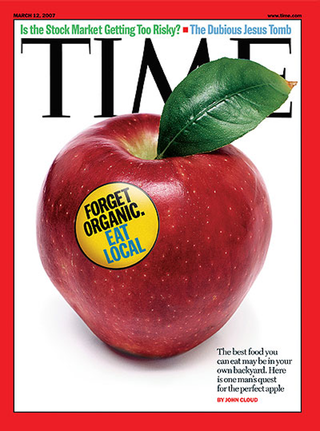When I spoke to Peter Hertzmann about Just Mayo, we talked a bit about the nature of mayonnaise. Now, here’s more, prompted by an article by Ari LeVaux (who told me a while ago why frozen beef is best).

Take a quick look at the picture above. Do the two sets of packaging look similar? I think they do. Certainly more similar than either of them is to Just Mayo’s jar.
 So here’s the question: if you were in a hurry, and looking for “real” mayonnaise, which would you pick up? Brown Just Mayo, or one of the blue-branded jars above?
So here’s the question: if you were in a hurry, and looking for “real” mayonnaise, which would you pick up? Brown Just Mayo, or one of the blue-branded jars above?
I thought so.
The jars above left are from a company called Follow Your Heart, which produces a range of vegan foods, including one called Vegenaise. To me, the package looks like Hellman’s mayonnaise. Even though it doesn’t claim to be mayonnaise, I’d assume it was. And yet, as far as I can tell, Vegenaise has had no trouble from the American Egg Board, the USDA, the FDA or Unilever, which own Best Foods, maker of Hellman’s mayonnaise. That may be because, unlike Just Mayo, it is targeting vegans, and nobody much cares what they buy.
But it makes a much more important point: there’s no big deal about the egg in mayonnaise, no matter what the FDA and its rules may say. The egg yolk is there purely to stabilise the emulsion of oil and water. In fact, there’s so little of it that all three — Hellman’s, Vegenaise and Just Mayo — record 0% protein on their nutrition labels.
The emulsifier is important, no doubt about that, but the exact chemical nature or source of that emulsifier is, to all intents and purposes, irrelevant. So, why the fuss?
Because of that definition of mayonnaise, I suppose. But the definition is completely past its sell-by date. It needs to change. And then maybe Vegenaise could change its name too and appeal to everyone who would rather not depend on the cheapest products of the chicken industry.
Meanwhile, Hampton Creek, maker of Just Mayo, is playing word games:
“The term ‘mayo’ should not now be held to the regulatory standard for ‘mayonnaise,’” wrote the company’s lawyer, Josh Schiller.
So yes, they’re guilty, bang to rights, of making a product that isn’t mayonnaise. But the fuddy-duddy old FDA is guilty of confusing “mayo” with “mayonnaise”.
“While there is a food standard of identity for ‘mayonnaise,’ there is no current standard for ‘mayo’. … Hampton Creek does not use the term ‘mayonnaise’ on any of its products or any of its marketing materials … If FDA had intended to cover products that use the term ‘mayo’ in its standard for mayonnaise, it could have done so, yet it did not.”
To which, I think, Vegenaise has countered with a neat little tag-line “It’s Better than Mayo”. I can’t swear to it, but I don’t think that was there when I first started looking at the stuff.
It’s fun watching this play out. I’ll stick to my whizzed concoction of tahini, yoghurt and lemon juice.

 The Dark Ages ran for about 400 years, from around the fall of the Roman Empire, in the middle of the 6th century, to around the 10th or 11th centuries. It was dark because the light of Rome had been extinguished, while that of the Renaissance had not yet burst into flame. And it was supposed to be a time when the culture and economy of Europe slumped. Peasants in scattered rural settlements scratched out a living in ignorance and obscurity. Recent archaeological excavations, however, have changed the way people look at the Dark Ages.
The Dark Ages ran for about 400 years, from around the fall of the Roman Empire, in the middle of the 6th century, to around the 10th or 11th centuries. It was dark because the light of Rome had been extinguished, while that of the Renaissance had not yet burst into flame. And it was supposed to be a time when the culture and economy of Europe slumped. Peasants in scattered rural settlements scratched out a living in ignorance and obscurity. Recent archaeological excavations, however, have changed the way people look at the Dark Ages.

 Wendell Berry, the American farmer, writer and thinker, famously said that “Eating is an agricultural act”. The quote now has a life of its own, but it is worth remembering that Berry used it to introduce a longer version of his advice to the urban consumer who wants to know what they can do. The short version is “eat responsibly”. To do that, though, you have to understand how agriculture and the food we eat are connected, how they form part of an entire system. My guest on this episode understands more than most people about how the various parts of the food system fit together, and it is a lot more complex than many people can imagine.
Wendell Berry, the American farmer, writer and thinker, famously said that “Eating is an agricultural act”. The quote now has a life of its own, but it is worth remembering that Berry used it to introduce a longer version of his advice to the urban consumer who wants to know what they can do. The short version is “eat responsibly”. To do that, though, you have to understand how agriculture and the food we eat are connected, how they form part of an entire system. My guest on this episode understands more than most people about how the various parts of the food system fit together, and it is a lot more complex than many people can imagine.